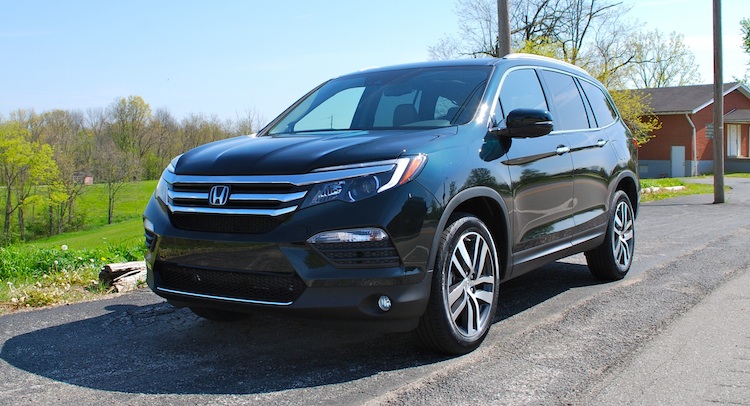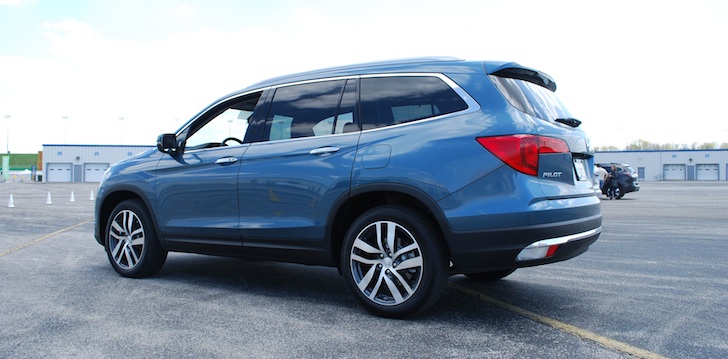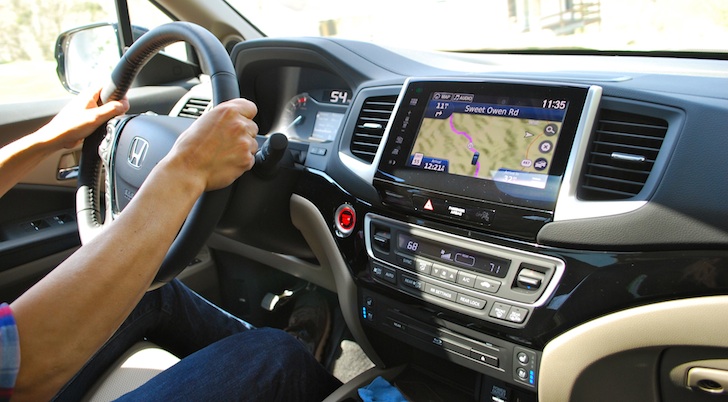When I slid behind the wheel of the all-new 2016 Honda Pilot last month, two things surprised me while driving somewhere in Kentucky.
First, I concluded that with age has come an appreciation for open spaces and green trees. But more relevant was that I didn’t feel parental behind the wheel of a seven-seat SUV the same size as some of the post offices I was passing.
It was in this Honda Pilot – the third incarnation of what arguably started many Americans down a three-row, car-based SUV path – that I realized a great road and willing engine can do a lot for a car.
Was I having fun driving something designed to haul an AYSO team?
Hip to be less square
Honda’s aim, however, was not to turn the Pilot into a corner-carving people mover. “Family function” and “premium appeal” were the phrases attached to the new car, and it’s reflected in the new styling that’s more mature than before.
The old Pilot’s Hummer-esque styling couldn’t have hit the market at a worse time. Introduced in 2008 just as the recession and high gas prices killed any interest in boxy, Tonka Truck-style trucks, the second-generation Pilot aged pretty rapidly. It was a misstep for a car regarded as a benchmark in its class.
The 2016 Pilot does go for a lower, longer theme, growing 3.5 inches in length and dropping an inch in height. Base models get 18-inch wheels as standard, but Touring and the new top-level Elite cars get handsome 20s. The Elite also benefits from new LED projector lights up front.
Honda’s goal with the 2016 Pilot is to push it upmarket and boost its popularity among women – almost 61 percent of second-gen Pilot buyers were men, according to the company’s figures. They say they pulled features from premium vehicles to give the Pilot a classier-than-expected look and feel. It works from the outside.
Honda has also gone so far from the faux-rugged outgoing model that the new Pilot actually looks more car-like than rivals such as the Ford Explorer and Toyota Highlander, forgoing much that would try to convince some that it belonged somewhere other than a Costco parking lot. And, frankly, it’s better for it.
Premium-ish
The interior is another place where the Pilot’s styling has dramatically improved. In terms of both style and quality, it now has less in common with a set of Duplo blocks.
That said, your knees will smack the hard plastic of the lower console and some lids and buttons feel thin. It’s not posh, but you might not mind so much when the dog eats the cupholders and the kids melt crayons on the seats.
Honda uses here the single-screen from the 2016 HR-V I tried earlier this year. It’s still awkward to use and hard to master while on the move. Fortunately, the Pilot gets Garmin navigation, which makes at least that part of the system a lot more intuitive.
Pilots have 8 seats, except for the Elite trim which gets second-row captain’s chairs that lower overall capacity to 7. One button slides the second-row seat forward, rather than messing with a sequence of straps and levers. The opening, however, isn’t that wide, so adults will look particularly silly getting in. That third row is tolerable for a 5-foot-10 individual like myself, but three people across the back is unlikely to end well. Still, the decision to keep the Pilot’s roofline upright pays off here.
Go for the Elite trim and your children will complain less thanks to a panoramic roof that joins the front moonroof to make a very airy cabin. Glass area is a Pilot strong point, as it has some of the best outward visibility of any crossover. The windows are large and upright, too.
Buckle up, kids
Grown-ups will discover the 2016 Pilot is unexpectedly fun in corners. Honda says it shaved 286 lbs. off compared to the old car – and that Pilot was already on the lighter side of this super-size-me class. It’s now 300 lbs. lighter than a Highlander Limited, for example. On the country roads where abandoned Ford Mavericks outnumbered people, I was having fun. Well, fun like a 16-year-old who just got his license and borrowed the family hauler to drive around town has fun.
I was only able to drive Touring and Elite models equipped with the 9-speed automatic, instead of a new-to-Pilot 6-speed unit that will send power to the wheels of LX, EX and EX-L models – which are expected to make up the other half of Pilot sales.
All models get a 3.5-liter V6 with 280 horsepower and 262 lb.-ft. of torque, which comes on strong. It’s a tad loud from the driver’s seat, but more enjoyable to rev than expected. Your kids will think you’re going faster than you really are.
The engine and handling tempt you to go faster, but unfortunately the steering has no desire to tell you what the front wheels are doing.
In fact, the only way I got much steering feel was by turning on the lane-keep assist that’s part of the Honda Sensing suite of safety features. The system was too nervous in trying to steer the car between the white lines on the highway. Honda Sensing also includes adaptive cruise control and a road departure prevention feature that was also a touch sensitive when I was trying to avoid a vulture in the road.
Only Elite models get blind-spot monitoring and parking sensors. Lower versions use Honda’s LaneWatch camera on the right-side mirror and a backup camera comes on all Pilots. The sensors were nice to have because a front or surround-view camera isn’t offered.
The start-stop system on Touring and Elite is surprisingly unobtrusive smooth when the light goes green. But in making quick getaways, the push-button gear selector on 9-speed cars defies logic – you wish for a chunky lever to throw into drive. I could only seem to get the Pilot in ninth gear by using the steering wheel-mounted shift paddles, too.
Enthusiastic backroads driving and moderate highway cruising got the trip computer to show me 24 MPG in the Elite AWD. Honda is gunning for 20/27 with the uplevel automatic, 19/27 with the base cars.
Great, if you don’t believe in minivans
Pricing kicks off at $29,995 before the $880 destination charge for a front-drive LX that will make up almost none of the 2016 Pilots you’ll see when they hit dealerships June 18. All-wheel drive is an $1,800 option on all trims except for the Elite, where it’s standard. Honda expects about half of sales will go to the more lavish Touring and Elite cars, which start at $41,900 for a front-drive Touring – including a rear-entertainment system and navigation. The Elite tops out at $47,300.
To me, that’s awfully close to an Acura MDX, which is actually a premium three-row crossover. And only that top Elite gets conveniences like the panoramic roof, blind-spot and rear cross-traffic monitors, heated steering wheel and rain-sensing wipers.
And the Pilot’s move upmarket is a half-step, anyway. Why does this car have a push-button gear selector, but a foot-operated parking brake? If the 9-speed auto is so great, why are half of Pilots getting the 6-speed? Why can’t the lower part of the dash be padded like on a 1994 Accord? I lost count of how many times a Honda engineer answered with, “Cost.”
Then there’s this: Why would you buy this – or any other three-row crossover – over a minivan? The Pilot just can’t match a Honda Odyssey’s space for people and things. You get a vacuum in the Odyssey, too. If you must spend money on all-wheel drive, there’s the Toyota Sienna.
But my record on converting suburban parents to minivans is pretty poor. For those with a standing reservation at Camp Crossover, the 2016 Pilot is a fine example and again worthy of being emulated.
And, in a way, it may make you feel like a kid again.
(Honda sent me on a plane to Kentucky and put me up in a hotel in Cincinnati, as well as paid for my food and drinks. They also gave me a tour of the Cincinnati Zoo, where I saw some large cats playing with a large ball.)
Photos: Zac Estrada/Carscoops















































